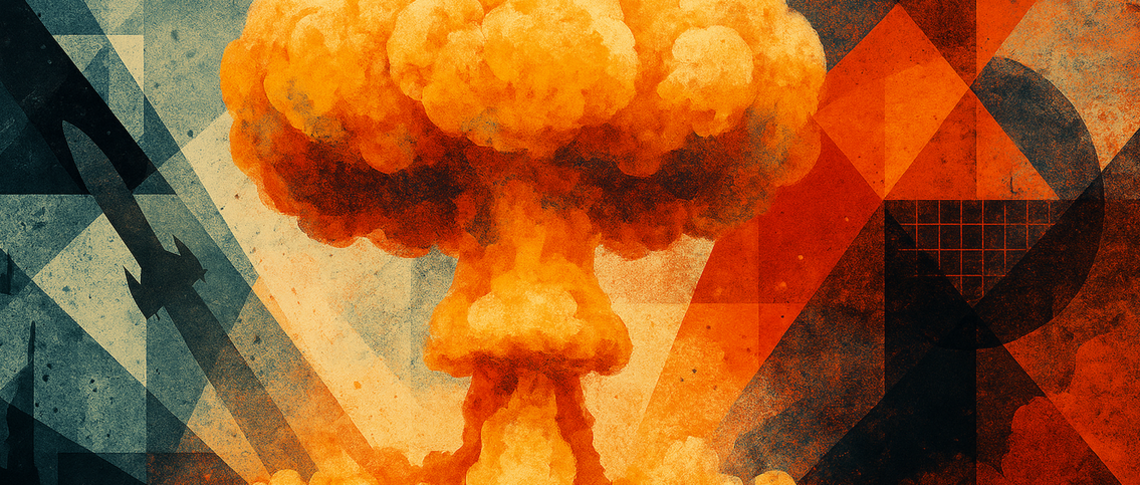The recently released thriller ‘A House of Dynamite’, now showing in cinemas and on Netflix, takes a powerful look at a topic that had long been considered a thing of the past following the end of the Cold War: the threat of nuclear Armageddon. In Kathryn Bigelow’s film, the US military suddenly discovers an intercontinental ballistic missile over the Pacific Ocean that could reach the US mainland within minutes. From different perspectives, the film tells how political and military decision-makers attempt to respond to the crisis. It becomes clear how vulnerable we are despite sophisticated defence systems and strategic war games, and how quickly a single attack using a nuclear weapon could escalate into a global catastrophe within minutes.
The film is not a distant fantasy, but reflects an increasingly realistic scenario of our present. The days when former US President Barack Obama promoted the vision of a nuclear-free world in Prague back in 2009 now seem like a thing of the distant past. In their place, we are witnessing the return of open threats of nuclear war, tactical nuclear strikes being discussed as a serious military option in the strategic considerations of the major powers, disarmament and arms control treaties expiring or being terminated, nuclear arsenals being modernised and new delivery systems being developed. The bitter truth is that the risk of nuclear conflict is probably higher today than ever before. We are on the threshold of a new nuclear age that is even more complex, unpredictable and uncertain than the so-called ‘balance of terror’ during the Cold War.
The People’s Republic of China now has at least 600 nuclear warheads. Experts believe that this number could rise to 1500 warheads by 2035.
The geopolitical context has changed dramatically in recent years. Since Russia’s attack on Ukraine, Moscow has tightened its nuclear doctrine and repeatedly threatened to use nuclear weapons. At the same time, China is massively expanding its nuclear arsenal. At a military parade celebrating the 80th anniversary of victory in World War II in September, Beijing presented its complete nuclear triad for the first time. According to the Stockholm Peace Institute SIPRI, the People’s Republic now has at least 600 nuclear warheads. Experts believe that this number could rise to 1500 warheads by 2035, reaching the level of the American and Russian nuclear arsenals.
A broader global trend
The world is currently moving towards a new tri- or even multipolar nuclear age. At present, nine countries possess nuclear weapons, including the five permanent members of the UN Security Council as well as Israel, India, Pakistan and North Korea. However, in view of growing global uncertainties and geopolitical tensions, more and more countries are considering developing their own nuclear capabilities. On 17 September 2025, Saudi Arabia and the nuclear power Pakistan signed a new defence agreement that includes a mutual assistance clause. The pact is not only a signal to potential regional rivals, but also illustrates the changing power structure in the Middle East, where the US is no longer perceived as a reliable security guarantor.
These regional shifts are also part of a broader global trend — the Pax Americana is gradually giving way to a multipolar world order in which the US is no longer willing or able to ensure international stability on its own. Dwindling confidence in American security guarantees means that it is no longer just opponents of the West, but even close allies of the US such as Japan and South Korea in the Indo-Pacific, as well as European countries, that are openly considering developing their own nuclear capabilities. Against the backdrop of these developments, Rafael Grossi, Director General of the International Atomic Energy Agency (IAEA), recently warned in an interview with Repubblica of a world with twenty to twenty-five nuclear-weapon states.
It is highly questionable whether a multipolar world with more than twenty nuclear-weapon states would actually contribute to greater security. The concept of deterrence presupposes a certain rationality and predictability on the part of the actors involved. But the more actors have nuclear weapons at their disposal, the greater the risk of irrational behaviour, misjudgements, misunderstandings, technical accidents and escalation dynamics. At the same time, a growing number of nuclear actors makes it considerably more difficult to establish binding rules for disarmament and arms control.
It is clear that substantial progress in the area of disarmament and arms control is not to be expected until the end of the war in Ukraine.
The existing system of disarmament and arms control is already on the brink of collapse. In recent years, both Russia and the United States have terminated the Intermediate-Range Nuclear Forces Treaty (INF) and the Open Skies Treaty. With the expiry of the New START Treaty in February 2026, there is a threat that the last remaining arms control agreement between the two largest nuclear powers will be lost. Although Putin recently proposed a one-year extension of the treaty, it remains uncertain whether this or even a successor agreement will actually come to fruition.
However, should Putin and Trump reach an agreement on New START, Germany and Europe will also be called upon to make concrete proposals for the preservation of multilateral arms control and a future European security order. For example, the planned deployment of American medium-range missiles in Germany next year could be embedded in an arms control offer if Moscow withdraws its land-based nuclear missiles in return.
At the same time, however, it is clear that substantial progress in the area of disarmament and arms control is not to be expected until the end of the war in Ukraine. In addition, China has so far refused to participate in talks on nuclear arms control and risk minimisation. Beijing emphasises that its nuclear arsenal remains significantly smaller than that of the US and Russia. For Washington, however, China's nuclear armament has long since become a strategic priority — increasing the risk of the world entering a phase in which more than twenty states possess nuclear weapons without any binding arms control treaties or risk minimisation agreements in place.
Counting on others and working together
It is therefore high time to breathe new life into the stalled efforts towards disarmament and arms control. The focus should be on limiting strategic nuclear arsenals and preserving the existing treaties. It is equally necessary to involve Beijing and other emerging nuclear powers in a new international arms control architecture and to prevent the further proliferation of nuclear weapons. The Nuclear Non-Proliferation Treaty is indispensable in this regard. Next year’s review conference must contribute to strengthening non-proliferation once again. A joint final document would send an important signal in the current international situation. At the same time, the UN remains indispensable for non-proliferation policy and must finally be equipped financially, in terms of personnel as well as structurally, so that it can fulfil its tasks effectively. In this regard, we can count on partners from the Global South who have long been committed to disarmament and want to play a greater role in shaping the international order in the future. Brazil, Indonesia and South Africa, for example, are members of regional treaties on nuclear-weapon-free zones. Support must be built here.
In addition, we need measures to reduce risk and increase transparency. These include direct military contacts, the announcement and observation of manoeuvres, and joint communication channels for crisis prevention. Future arms control agreements must also take into account new risks arising from artificial intelligence or hypersonic weapons and in cyberspace and outer space.
In recent decades, the international community has succeeded in reducing the threat of nuclear Armageddon through cooperation and confidence-building in disarmament and arms control. This remains possible and necessary. However, the prerequisite for this is and remains the political will of the relevant actors, which has been sorely lacking in recent years.






